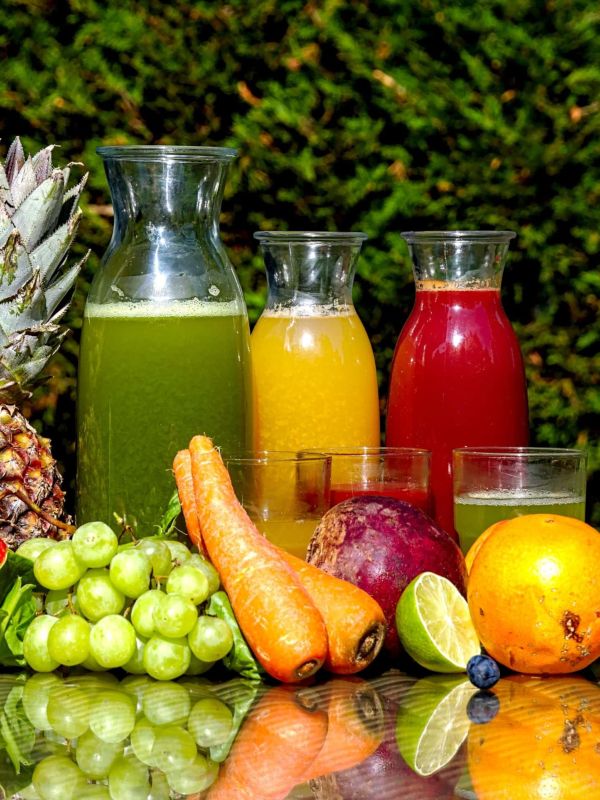Juicing is becoming a frequent approach to try and lower blood pressure naturally. The first person to talk about juicing for high blood pressure was Dr Norman W. Walker (born 1886, he died a hundred years later in 1985!). He authored several books about the benefits of juicing for health, including one specifically about the benefits of juicing for high blood pressure.
In his book, Dr Walker explains the importance of adding freshly made juices to the diet to improve overall health, including reducing high blood pressure. Additionally, the natural antioxidants in fresh juices can help protect your cells from damage caused by free radicals[1], which can contribute to hypertension.
It is important to note, however, that juicing cannot replace a healthy diet and daily lifestyle, so it is best to combine it with other lifestyle changes such as regular exercise and having a balanced diet.
The NHS has the Eatwell Guide to help anyone with hypertension who wants to make healthy changes to their diet. Drinking juices is another great way to incorporate the recommended 5-a-day fruit and veg.
How to make the juice at home?
There are several distinct types of juicers available on the market. The two most popular types are masticating juicers and centrifugal juicers.
Masticating juicers use a single auger to grind, chew, and break down fruits and vegetables before extracting the juice. This type of juicer is very gentle on the produce, preserving most of the vitamins and minerals.
Centrifugal juicers use a blade to cut the fruits and vegetables into small pieces before pushing them through a sieve. These juicers are faster and tend to be less expensive, but they can also be less effective at extracting all the juice and preserving the nutrients.
What do you need to add to your weekly shopping list?
Some of the most accessible fruits and vegetables in the northern hemisphere that can help reduce high blood pressure include beets, oranges, apples, carrots, spinach, kale, celery, and cucumbers.
“Drinking fresh juice for breakfast can have a double impact on your blood pressure. Not only can the vitamins, minerals, and antioxidants in the juice help reduce inflammation and improve circulation, but the energy provided by the juice can also help to stabilize blood pressure throughout the day.”
Connecting Aktiia with drinking fresh juice for breakfast can help you to check the effect that the juice is having on your blood pressure. Device allows you to easily track your blood pressure levels and can help you identify patterns and trends.
To stay up to date and receive the latest tips on how to lower blood pressure please provide email below:
You can mix a variety of fruit and veg into juicers and smoothies. Have a read below recipes for natural juices which we know may lower blood pressure.
Juicing Recipes to Lower Blood Pressure
Creating your own juicing recipe is easy, all you need are the ingredients and a juicer. Mix the ingredients in your juicer until the consistency is liquified enough to drink comfortably. You can always add a small amount of water if the consistency is too thick. Our recommended dosage is 1 to 3 servings of juice daily. Below we discuss the best juicing recipes to try.
Green Juice
Green juice also known as vegetable juice has many vegetables included that are nitrate and potassium heavy. Both solutes enhance blood flow in the body.
Ingredients:
- 1 apple
- 2 cucumbers
- 4 celery sticks
- 1 large bunch of parsley
- 1 peeled lemon
- 1 knob of ginger
The amount is enough for one serving.
Beet Carrot Pineapple Orange Juice
Any juice containing beets will always be filled with nitrates. We have a recipe with some adjustments specifically for hypertension.
Ingredients:
- 1 large, peeled beet or 2 small, peeled beets
- 4 peeled or unpeeled large carrots
- half a pineapple with the core
- 2 peeled medium oranges
You can add ginger for an extra kick. This is enough for three servings.
Naturally Sweet, Green Detox Juice
This natural recipe combines spinach that is known to have strengthening nutrients for the heart, such as folate and magnesium. Spinach also has lutein, which is known to help prevent the artery walls from thickening and therefore may help lower the risk of high blood pressure and strokes. The recipe also contains potassium and polyphenol-rich apples, and other blood pressure reducing ingredients such as cucumber, parsley, lemon, and ginger.
Ingredients:
- 2 cups of spinach leaves
- 1 handful of parsley with the stems
- 1 medium green apple
- 1 cucumber
- 1 knob of ginger
- 1 medium lemon
This is enough for two servings.
Tropical Carrot Juice
This recipe is great if you like the taste of refreshing juice. It has natural sweeteners that soothe your tastebuds, and all the ingredients are known to lower blood pressure. Carrots have phenolic compounds and caffeic acids that reduce inflammation and strain of the blood vessels.
Ingredients:
- 2 large carrots
- half of a large mango
- half of the pineapple including the core
- 1 tsp of grated ginger
- 2 tsp of water
This is for 2 servings.
Beetroot Juice
Drinking a glass of beetroot juice can help lower blood pressure according to research done at Queen Mary University London, as beets contain high amounts of nitrates. Nitric oxide helps the blood vessels relax and dilate, which increases the blood flow throughout the body. Eating and drinking produce that boosts nitric oxide levels may reduce high blood pressure for a few hours, sometimes even up to days.
Ingredients:
- 1 large beet chopped
- half a lemon
- 1 apple
This is for 2 servings.
Juicing can be a relatively easy and affordable start on the path to lower blood pressure. Monitoring your blood pressure levels with Aktiia can help you identify trends and patterns, and adjust your diet, and lifestyle accordingly. It is important to remember that juicing cannot replace a healthy diet and lifestyle, so it should be combined with other lifestyle changes to achieve the best results.
Disclaimer: If you have hypertension, we encourage you to speak to your healthcare professional if you plan to take juicing recipes.
Footnotes:
1 “Reactive oxygen species (ROS) are formed by oxidation-reduction reactions in which one molecule is reduced by removal of an electron, which is then transferred to a recipient molecule. ROS can be divided into two major groups: free radicals and non-radical derivatives. Free radicals possess an unpaired electron in their outer orbital, which make them highly reactive.” – https://www.ncbi.nlm.nih.gov/pmc-articles/PMC5125524
Sources:
Beetroot juice will lower BP in men when consumed as part of a normal diet in free-living healthy adults, Nutrition Journal, Dec 2012 – https://www.ncbi.nlm.nih.gov/articles-PMC3545899
Fruit Juice appears to be associated with benefits rather than risks, especially in relation to vascular health and nutrient adequacy, Nutrients MDPI, May 2021 – https://www.ncbi.nlm.nih.gov/articles-PMC8228760
Consumption of juice could prevent the increase of blood pressure, International Journal of Molecular Sciences, MDPI, Mar 2017 – https://www.ncbi.nlm.nih.gov/articles-PMC5372571
5 Surprising Health Benefits of Orange Juice, Feb 2019 – https://www.healthline.com/nutrition-orange-juice-benefits
Orange juice associated with a balanced diet mitigated risk factors of metabolic syndrome, Journal of Nutrition & Intermediary Metabolism, Sep 2019 – https://www.sciencedirect.com/science-article-S2352385919300167


